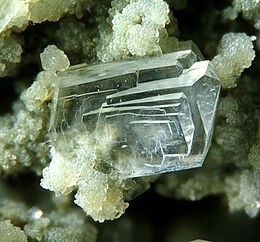
Clinoptilolite
Clinoptilolite is a natural zeolite composed of a microporous arrangement of silica and alumina tetrahedra. It has the complex formula (Na,K,Ca)2–3Al3(Al,Si)2Si13O36•12H2O. It forms as white, green to reddish tabular monoclinic tectosilicate crystals with a Mohs hardness of 3.5 to 4 and a specific gravity of 2.1 to 2.2. It commonly occurs as a devitrification product of volcanic glass shards in tuff and as vesicle fillings in basalts, andesites and rhyolites. It was described in 1969 from an occurrence in the Barstow Formation, San Bernardino County, California. Sodium levels in clinoptilolite are generally higher than potassium levels, as is the case with the San Bernardino Barstow Formation, but there are sources that are potassium-rich and have minimal sodium.It forms a series with heulandite:
Clinoptilolite-Ca – heulandite-Ca solid solution series
Clinoptilolite-K – heulandite-K solid solution series
Clinoptilolite-Na – heulandite-Na solid solution seriesUse of clinoptilolite in industry and academia focuses on its ion exchange properties having a strong exchange affinity for ammonium (NH4+). A typical example of this is in its use as an enzyme-based urea sensor.The name is derived from the Greek words klino (κλίνω; “oblique”), ptylon (φτερών; “feather”), and lithos (λίθος; “stone”).
Read More About Clinoptilolite

